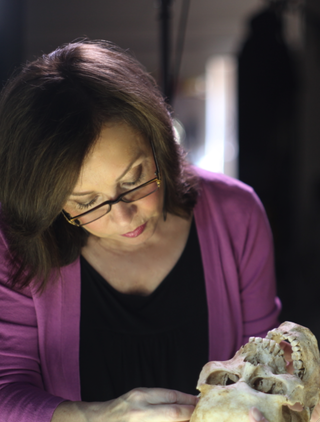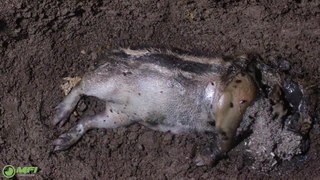Related Research Articles

Decomposition or rot is the process by which dead organic substances are broken down into simpler organic or inorganic matter such as carbon dioxide, water, simple sugars and mineral salts. The process is a part of the nutrient cycle and is essential for recycling the finite matter that occupies physical space in the biosphere. Bodies of living organisms begin to decompose shortly after death. Animals, such as earthworms, also help decompose the organic materials. Organisms that do this are known as decomposers or detritivores. Although no two organisms decompose in the same way, they all undergo the same sequential stages of decomposition. The science which studies decomposition is generally referred to as taphonomy from the Greek word taphos, meaning tomb. Decomposition can also be a gradual process for organisms that have extended periods of dormancy.
Putrefaction is the fifth stage of death, following pallor mortis, livor mortis, algor mortis, and rigor mortis. This process references the breaking down of a body of an animal post-mortem. In broad terms, it can be viewed as the decomposition of proteins, and the eventual breakdown of the cohesiveness between tissues, and the liquefaction of most organs. This is caused by the decomposition of organic matter by bacterial or fungal digestion, which causes the release of gases that infiltrate the body's tissues, and leads to the deterioration of the tissues and organs. The approximate time it takes putrefaction to occur is dependent on various factors. Internal factors that affect the rate of putrefaction include the age at which death has occurred, the overall structure and condition of the body, the cause of death, and external injuries arising before or after death. External factors include environmental temperature, moisture and air exposure, clothing, burial factors, and light exposure. Body farms are facilities that study the way various factors affect the putrefaction process.

Forensic anthropology is the application of the anatomical science of anthropology and its various subfields, including forensic archaeology and forensic taphonomy, in a legal setting. A forensic anthropologist can assist in the identification of deceased individuals whose remains are decomposed, burned, mutilated or otherwise unrecognizable, as might happen in a plane crash. Forensic anthropologists are also instrumental in the investigation and documentation of genocide and mass graves. Along with forensic pathologists, forensic dentists, and homicide investigators, forensic anthropologists commonly testify in court as expert witnesses. Using physical markers present on a skeleton, a forensic anthropologist can potentially determine a person's age, sex, stature, and race. In addition to identifying physical characteristics of the individual, forensic anthropologists can use skeletal abnormalities to potentially determine cause of death, past trauma such as broken bones or medical procedures, as well as diseases such as bone cancer.

Scavengers are animals that consume dead organisms that have died from causes other than predation or have been killed by other predators. While scavenging generally refers to carnivores feeding on carrion, it is also a herbivorous feeding behavior. Scavengers play an important role in the ecosystem by consuming dead animal and plant material. Decomposers and detritivores complete this process, by consuming the remains left by scavengers.
A body farm is a research facility where decomposition of humans and animals can be studied in a variety of settings. The initial facility was conceived by anthropologist William M. Bass in 1981 at the University of Tennessee in Knoxville, Tennessee, where Bass was interested in studying the decomposition of a human corpse from the time of death to the time of decay. The aim was to gain a better understanding of the decomposition process, permitting the development of techniques for extracting information such as the timing and circumstances of death from human remains. Body farm research is of particular interest in forensic anthropology and related disciplines, and has applications in the fields of law enforcement and forensic science. By placing the bodies outside to face the elements, researchers are able to get a better understanding of the decomposition process.

William Marvin Bass III is an American forensic anthropologist, best known for his research on human osteology and human decomposition. He has also assisted federal, local, and non-U.S. authorities in the identification of human remains. He taught at the University of Tennessee in Knoxville, and founded the University of Tennessee Anthropological Research Facility, the first such facility in the world. The facility is more popularly known as "The Body Farm", a name used by crime author Patricia Cornwell in a novel of the same name, which drew inspiration from Bass and his work. Bass has also described the body farm as "Death's Acre" – the title of the book on his life and career, co-written with journalist Jon Jefferson. Jefferson and Bass, under the pen name "Jefferson Bass", have also written several fictional works: Carved In Bone, Flesh and Bone, The Devil's Bones, Bones of Betrayal, The Bone Thief, The Bone Yard, The Inquisitor's Key, Cut To the Bone, and The Breaking Point. Though currently retired from teaching, Bass still plays an active research role in the university's forensic anthropology program.

The Body Farm is a crime fiction novel by Patricia Cornwell. It is the fifth book in the Dr. Kay Scarpetta series.

Skeletonization is the state of a dead organism after undergoing decomposition. Skeletonization refers to the final stage of decomposition, during which the last vestiges of the soft tissues of a corpse or carcass have decayed or dried to the point that the skeleton is exposed. By the end of the skeletonization process, all soft tissue will have been eliminated, leaving only disarticulated bones.

Karen T. Taylor is an American forensic and portrait artist who has worked to help resolve criminal cases for a variety of law enforcement agencies throughout the world. Her primary expertise includes composite imagery, child and adult age progression, postmortem drawing and forensic facial reconstruction. In the mid-1980s, Taylor pioneered the method of 2-dimensional facial reconstruction, by drawing facial features over frontal and lateral skull photographs based on anthropological data. Taylor is also well-established as a forensic art educator, fine art portrait sculptor, and specialist in the human face.
The University of Tennessee Anthropological Research Facility, better known as the Body Farm and sometimes seen as the Forensic Anthropology Facility, was conceived in 1971 and established in 1972 by anthropologist William M. Bass as the first facility for the study of decomposition of human remains. It is located a few miles from downtown Knoxville, Tennessee, United States, behind the University of Tennessee Medical Center, and is part of the Forensic Anthropology Center, which was established by Dr. Bass in 1987.
Arpad Alexander Vass is a research scientist and forensic anthropologist. He is also a teaching associate with the Law Enforcement Innovation Center, which is part of the University of Tennessee's Institute for Public Service.
The Freeman Center is a 3,485-acre (1,410 ha) plot of land between San Marcos and Wimberley, Texas. It was founded in 1941 by weekend ranchers Harold M. "Harry" Freeman and his brother Joe. The Freeman Center houses the Texas State University Forensic Anthropology Center's body farm, where the deceased are used to study the various stages of body decomposition and their effects on the soil.

Texas State University (TXST) is a public research university with its main campus in San Marcos, Texas and another campus in Round Rock. Since its establishment in 1899, the university has grown to be one of the largest universities in the United States. Texas State University reached a record enrollment of 38,873 students in the 2023 fall semester, continuing a trend of enrollment growth over several years.
The University of North Texas Center for Human Identification is a national resource for the identification of missing and unidentified persons at the University of North Texas Health Science Center. UNTCHI combines the services of a forensic DNA laboratory, a forensic anthropology laboratory, and the Forensic Services Unit (FSU). The center operates the National Missing and Unidentified Persons System (NamUs) and Project EDAN which helps identify human remains.
Jon Jefferson is a contemporary American author and television documentary maker. Jefferson has written ten novels in the Body Farm series under the pen name Jefferson Bass, in consultation with renowned forensic anthropologist William M. Bass, as well as two non-fiction books about Bass's life and forensic cases.
The smell of death is a smell occurring during decomposition. It is made up of over 800 different chemicals. There have been efforts to synthesize the smell of death. It has also been used as evidence in court trials involving murder.
The necrobiome has been defined as the community of species associated with decaying corpse remains. The process of decomposition is complex. Microbes decompose cadavers, but other organisms including fungi, nematodes, insects, and larger scavenger animals also contribute. Once the immune system is no longer active, microbes colonizing the intestines and lungs decompose their respective tissues and then travel throughout the body via the blood and lymphatic systems to break down other tissue and bone. During this process, gases are released as a by-product and accumulate, causing bloating. Eventually, the gases seep through the body's wounds and natural openings, providing a way for some microbes to exit from the inside of the cadaver and inhabit the outside. The microbial communities colonizing the internal organs of a cadaver are referred to as the thanatomicrobiome. The region outside of the cadaver that is exposed to the external environment is referred to as the epinecrotic portion of the necrobiome, and is especially important when determining the time and location of death for an individual. Different microbes play specific roles during each stage of the decomposition process. The microbes that will colonize the cadaver and the rate of their activity are determined by the cadaver itself and the cadaver's surrounding environmental conditions.

Decomposition is the process in which the organs and complex molecules of animal and human bodies break down into simple organic matter over time. In vertebrates, five stages of decomposition are typically recognized: fresh, bloat, active decay, advanced decay, and dry/skeletonized. Knowing the different stages of decomposition can help investigators in determining the post-mortem interval (PMI). The rate of decomposition of human remains can vary due to environmental factors and other factors. Environmental factors include temperature, burning, humidity, and the availability of oxygen. Other factors include body size, clothing, and the cause of death.
Mortuary archaeology is the study of human remains in their archaeological context. This is a known sub-field of bioarchaeology, which is a field that focuses on gathering important information based on the skeleton of an individual. Bioarchaeology stems from the practice of human osteology which is the anatomical study of skeletal remains. Mortuary archaeology, as well as the overarching field it resides in, aims to generate an understanding of disease, migration, health, nutrition, gender, status, and kinship among past populations. Ultimately, these topics help to produce a picture of the daily lives of past individuals. Mortuary archaeologists draw upon the humanities, as well as social and hard sciences to have a full understanding of the individual.
Professor Shari L. Forbes is an Australian and Canadian forensic scientist and researcher. She is a thanatology expert on the decomposition of human bodies. She created a body farm in Australia and between 2019 and 2022 established a similar facility in Canada, connected to the Forensic Science department at Université du Québec à Trois-Rivières (UQTR). As of January 2023, she is a full professor in chemistry and biochemistry at the University of Windsor, and is hoping to start the first body farm in Ontario in the coming years.
References
- ↑ "TEEX Blog: TEEX + FACTS = CSI at The Body Farm". teexblog.blogspot.com. Archived from the original on 2012-03-25.
- ↑ "Listening to the Bones".
- ↑ "Forensic Anthropology Center Faculty". Texas State University. Archived from the original on 2010-05-28. Retrieved 2009-11-28.
- ↑ "Vultures pick off human body farm". BBC. 2007-05-11. Retrieved 2006-05-11.
- ↑ "Texas State Forensic Research Facility to locate at Freeman Ranch". Texas State University. Archived from the original on 2010-06-02. Retrieved 2008-02-12.
- ↑ "Listening to the Bones - Texas State opens the world's largest forensic anthropology research facility". The Austin Chronicle. Retrieved 2008-04-04.
- ↑ Reeves, NM 2009 Taphonomic Effects of Vulture Scavenging. Journal of Forensic Sciences 54:523-528.
- ↑ "Listening to the Bones Texas State opens the world's largest forensic anthropology research facility". The Austin Chronicle. Retrieved 2009-11-27.
- ↑ "Introduction to Freeman Ranch" . Retrieved 2009-11-27.
